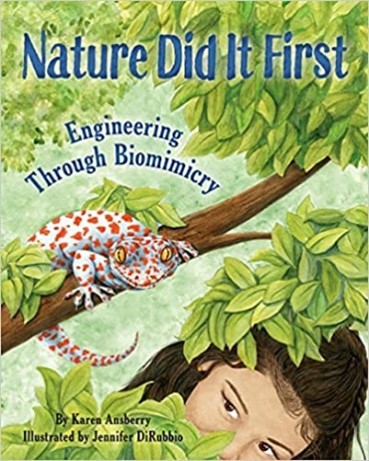Early childhood resources review
Nature Did It First: Engineering Through Biomimicry
Science and Children—July/August 2023 (Volume 60, Issue 6)
By Julie Petcu

Nature Did It First: Engineering Through Biomimicry
by Karen Ansberry
May, 2020
Dawn Publications
32 pages
$14.33
Teachers of young children frequently engage in the fun activity where they ask their students to “hop like a rabbit,” “fly like a bird,” and perhaps “be busy as bees.” This simple use of similes not only engages students kinesthetically but can also act as a springboard to further children’s deep curiosity about the natural world and the discovery of additional characteristics of plants and animals. But, what if these newly observed characteristics are so beneficial in nature that copying and building on that design could improve our own lives? This process of emulating and engineering those benefits of nature to solve human problems is known as biomimicry.
Preschool educators often study nature as the first exposure to life science; however, finding an equally exciting and meaningful connection for engineering practices may be elusive. Karen Ansberry’s book, Nature Did It First: Engineering Through Biomimicry, could be that useful bridge to unite young children’s love of nature to the world of problem-solving engineers.
Karen Ansberry, is a teacher, writer, and a lover of nature. During her 25+ years as an educator, she has authored several books integrating literature and science. Nature Did It First, Ansberry’s first children’s book, is brightly illustrated by Jennifer DiRubbio. Each of the book’s seven divisions is dedicated to a plant or animal with a useful trait that can benefit human society. The sections highlight burrs (hooks that cling), bats (echolocation), geckos (stick and unstick), pitcher plants (slippery surfaces), humpback whales (bumpy flippers), pill bugs (rolling into a ball), and kingfishers (streamlined shape). Children will enjoy the lively short poems and prose in each section that outline how nature did it first. At the end of each section, she asks, “What other problems could be solved?”
At the end of the book is a helpful glossary of terms and information about obtaining a STEM Biomimicry Design Challenge. The publisher’s link to the teaching guides and handouts is no longer functioning. However, the documents can be found at a companion site listed in below. While these safe and inexpensive activities are geared for slightly older students, astute preschool teachers could provide effective modification such as providing animal picture books, preparing lists on poster paper in front of the students, and collecting/documenting ideas. Students’ engineering designs can be drawn, discussed, or built using materials already available in the classroom. Students will delight in sharing their ideas with the class!
In the NSTA Position Statement for Early Childhood Science Education (2014), it is stated that exposing young children (three years through preK) to science and engineering practices builds on their natural curiosity and excitement about the world they live in. These enriching classroom experiences also create a foundation for successful learning in K–12. Similarly, in 2022, the National Academies of Science, Engineering, and Medicine (NASEM) called for early childhood students to experience the wonder of the natural world and engage in engineering. Incorporating Nature Did It First in the preschool classroom provides everything that is desirable for quality early childhood science experiences: ties to literacy, using observation skills, asking questions, identifying problems, designing solutions, developing models or constructs, and communicating information.
So next time you are watching ketchup slide from its bottle, thank the pitcher plant for the slippery coating...because, nature did it first!
References
National Academies of Science, Engineering, and Medicine: www.nationalacademies.org/event/09-15-2022/enhancing-science-and-engineering-in-prekindergarten-through-fifth-grade-public-event-washington-dc
NSTA Position Statement: Early Childhood Science Education: https://static.nsta.org/pdfs/PositionStatement_EarlyChildhood.pdf
Online Resource
STEM Biomimicry Design Challenge and Teaching Guide for this book: https://cdn.sourcebooks.com/assets/downloads/activitykits/NatureDidItFirst-ActivityKit.pdf
Julie Petcu is an experienced science educator for students of all ages including college preservice education majors. While no longer in the classroom, she is actively involved with NSTA, TSTA, and NAEYC. She has also completed the Tennessee Certified Naturalist training.
Biology Life Science Literacy Early Childhood


